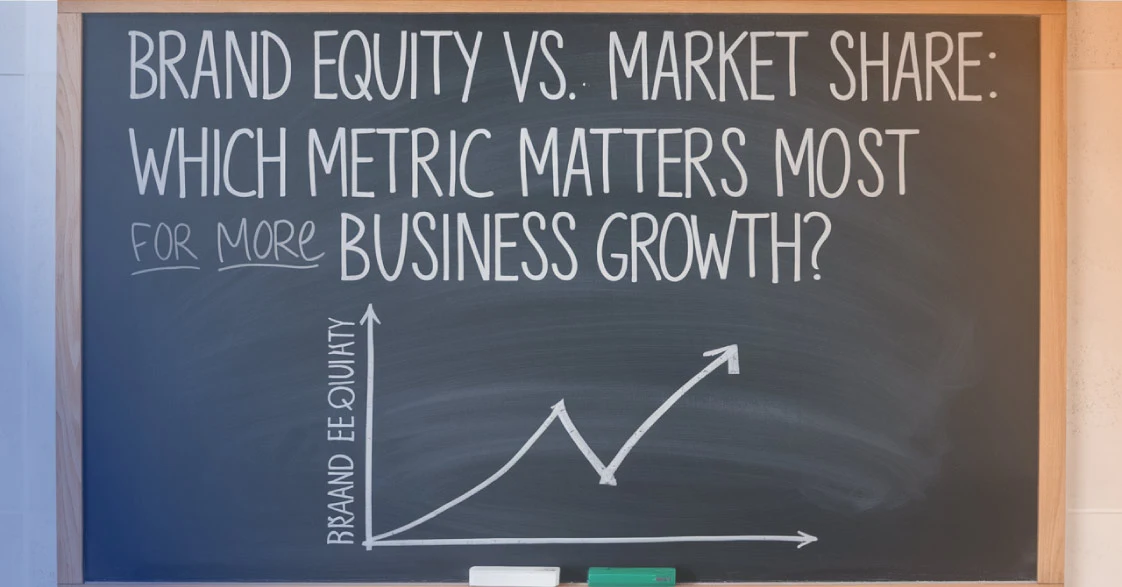Brand Equity vs. Market Share: Which Metric Matters Most for Business Growth?

Understanding the critical metrics for business growth is crucial in today's competitive market. Brand Equity and Market Share are critical indicators among the many metrics available. While both play significant roles, their impact on growth can vary based on the industry, business model, and long-term goals. This blog explores their definitions, importance, and strategic implications to help businesses decide which metric to prioritize.
What is Brand Equity?
Definition
Brand equity is the intangible value a brand adds to a product or service to further its functional benefits. It is a cumulative result of customer perceptions, experiences, and emotional connections with the brand. Substantial brand equity increases customer loyalty, advocacy, and willingness to pay a premium. For example, customers often choose products from a well-known brand even if they cost more than similar products from lesser-known competitors.
Components of Brand Equity
1. Brand Awareness
Brand awareness is the basis of brand equity. It measures the degree to which consumers recognize or recall a brand. High brand awareness ensures a brand is top-of-mind for consumers when they need a product or service in a particular category. For example:
- A cola drink company with high brand awareness is the first one people think of when buying soft drinks.
- Consistent marketing, advertising, and the presence of a memorable brand logo or tagline can result in strong awareness.
2. Brand Loyalty
Brand loyalty reflects the degree of commitment consumers have toward a brand. Loyal customers consistently choose the same brand over alternatives, regardless of price or promotional offers. This helps corporations reduce their marketing expenditure, as keeping existing customers is more practical than gaining new ones. Additionally:
- Loyal customers often become brand advocates, promoting the brand through word-of-mouth.
- Loyalty programs and superior customer service can further strengthen this component.
3. Perceived Quality
Perceived quality is how customers judge the overall excellence of a product or service compared to competitors. This perception influences purchasing decisions, and high-quality brands often command premium pricing. For example:
- A luxury watch brand known for its craftsmanship will likely be perceived as high-quality.
- Factors influencing perceived quality include product performance, durability, and brand reputation.
Measurement of Brand Equity
1. Brand Valuation Models
Quantitative methods help assign a financial value to a brand. Examples include:
- Discounted Cash Flow Models: Estimate future cash flows a brand is expected to generate.
- Royalty Relief Method: Determines the cost a company would incur if it had to license its brand name.
2. Brand Equity Surveys
Surveys gather customer insights on key attributes like brand awareness, loyalty, and perceived quality. These surveys can:
- Identify areas where a brand excels or needs improvement.
- Highlight opportunities to strengthen the brand's market position.
Importance of Brand Equity
1. Sustainable Competitive Advantage
A brand with substantial equity occupies a unique and defensible position in the market. Competitors find it challenging to replicate the emotional connection and trust the brand has built with its customers.
2. Premium Pricing Power
Brands with high equity can charge more for their products or services without losing customers. For instance:
- A premium smartphone brand can charge significantly more than budget options because of its reputation for innovation and quality.
3. Brand Extension Opportunities
Positive brand equity enables a business to introduce new products under the same brand umbrella with reduced risk. Customers are more likely to test a new product if they trust the brand behind it.
What is Market Share?
Definition
Market share measures a company's sales volume or revenue as a percentage of the total industry sales in a specific market. It indicates a company's competitiveness and market dominance.
Key Metrics for Market Share
1. Unit Sales
Unit sales refer to the total number of products a company sells relative to competitors. Tracking unit sales provides insights into:
- The company's performance in volume-driven markets.
- Market trends and consumer preferences.
2. Revenue
Revenue market share represents the proportion of total industry revenue a company captures. This metric reflects financial performance and pricing strategies. For example:
- A company with premium-priced products might have a lower unit share but a higher revenue share.
3. Industry Reports and Sales Tracking
Analyzing industry reports and sales data helps companies benchmark their performance against competitors. These insights are valuable for:
- Identifying growth opportunities.
- Understanding market trends and customer behaviour.
Importance of Market Share
1. Economies of Scale
Achieving a significant market share enables businesses to produce goods in larger quantities, reducing per-unit costs. This provides a competitive advantage by:
- Lowering production expenses.
- Enabling competitive pricing.
2. Bargaining Power
A company with a significant market share gains leverage over suppliers and distributors. For example:
- Suppliers may offer discounts or priority services to maintain relationships with a leading market player.
- Distributors are more likely to prioritize top-selling products.
3. Competitive Positioning
Market share reflects a company's dominance and reliability in customers' eyes. A company with a large share is often seen as an industry leader, which attracts more customers seeking trusted brands.
Detailed Explanation: Brand Equity vs. Market Share
Relationship Between Brand Equity and Market Share
1. Positive Correlation
Brand equity and market share are often interlinked. A brand with substantial equity naturally attracts more customers, leading to a higher market share. For example:
- Brand Loyalty: Customers loyal to a brand consistently choose it over competitors, leading to sustained sales and market dominance.
- Perceived Quality: A brand known for superior quality will likely capture a larger market share, as consumers prefer trusted brands.
However, the relationship is not always straightforward, as discussed in the next point.
2. Exceptions and Tradeoffs
While high brand equity often leads to higher market share, there are exceptions:
- Low Pricing Strategies: Some brands achieve significant market
share by offering the lowest prices, which can dilute the perception of quality.
For instance:
- A low-cost electronics brand may dominate sales but lack substantial equity due to perceived inferior quality.
- Premium Positioning: Conversely, a luxury brand may have limited market share due to its high price point but enjoys substantial brand equity, enabling long-term profitability.
Strategic Implications
1. Brand-Driven vs. Volume-Driven Growth
- Brand-Driven Growth:
- This strategy cultivates strong customer relationships through superior quality,
trust, and experience. Key features include:
- Higher margins due to premium pricing.
- Long-term sustainability is driven by loyalty.
- Examples: Premium products like luxury watches or organic foods thrive on brand-driven growth.
- Volume-Driven Growth:
- This strategy prioritizes capturing as much market share as possible, often
through cost leadership. Features include:
- Competitive pricing to attract price-sensitive customers.
- High sales volumes that benefit from economies of scale.
- Examples: FMCG products like basic toiletries often focus on volume-driven strategies.
2. Balancing Brand Equity and Market Share
The most successful businesses balance these two metrics. For example:
- A premium electronics brand maintains high equity by offering superior quality while strategically introducing mid-range products to increase market share.
- A balanced approach ensures steady revenue in the short term and sustainability in the long term.
Business Growth Factors Influenced by Brand Equity and Market Share
1. Customer Satisfaction
Customer satisfaction is a critical driver of both metrics. It fosters loyalty and positive word-of-mouth, which, in turn, impacts equity and share.
- a. Brand Experience:
- Delivering exceptional customer experiences at every touchpoint strengthens brand perception, ensuring long-term loyalty.
- b. Post-Purchase Loyalty:
- Satisfied customers repurchase and recommend the brand to others, boosting equity and share.
2. Innovation
- a. Product Development:
- Innovation enhances perceived quality, a core element of brand equity. For
example:
- A smartphone company introducing groundbreaking features attracts new customers, increasing market share.
- b. Market Expansion:
- Expanding into new markets helps grow both metrics. For instance:
- Launching a product in an emerging market increases share while maintaining consistent quality and builds equity.
3. Pricing Strategy
- a. Premium Pricing:
- Brands with high equity can command premium prices, resulting in better margins.
For example:
- A high-end skincare brand can charge more due to its reputation for quality and effectiveness.
- b. Competitive Pricing:
- Companies focusing on market share often adopt aggressive pricing strategies to
attract cost-conscious customers. For example:
- A discount retail chain gains market share through competitive pricing, though it may not develop substantial equity.
Case Studies: Industry-Oriented Insights
Case Study 1: Consumer Electronics Industry
- Scenario: A premium electronics brand aimed to enhance perceived quality and customer loyalty through innovative features and robust after-sales support.
- Outcome: The focus on brand equity enabled sustainable growth and increased market share in the premium segment.
Case Study 2: FMCG Industry
- Scenario: An FMCG company captured significant market share by offering competitively priced products. However, the lack of strong brand loyalty hindered its ability to sustain premium pricing.
- Outcome: The focus on volume-driven growth provided short-term gains but limited long-term sustainability.
Case Study 3: Automobile Industry
- Scenario: An automobile manufacturer emphasized innovation and brand trust while targeting diverse market segments.
- Outcome: By balancing brand equity with market share, the company achieved strong financial performance and customer loyalty.
Table: Key Differences Between Brand Equity and Market Share
| Metric | Brand Equity | Market Share |
| Focus | Perception and trust | Sales and market dominance |
| Measurement | Surveys, valuation models | Revenue, unit sales |
| Importance | Long-term sustainability | Short-term competitiveness |
| Pricing Impact | Enables premium pricing | Drives cost-effective pricing |
| Growth Strategy | Brand-driven | Volume-driven |
Which Metric Matters Most?
For Long-Term Growth
Brand equity is vital for businesses seeking sustained growth. By fostering customer trust and loyalty, brands can:
- Charge premium prices.
- Extend into new product categories or markets with minimal risk.
For Short-Term Revenue
Market share is crucial for companies aiming to dominate a market quickly. High sales volumes enable:
- Cost reductions through economies of scale.
- Increased bargaining power with suppliers and distributors.
Final Words
Both brand equity and market share are essential for business growth. Companies must evaluate their industry, target audience, and objectives to determine the proper focus. Balancing these metrics can lead to sustainable success, ensuring steady revenue and a strong market presence. By understanding the strategic implications of each, businesses can make informed judgments and thrive in competitive markets.

FAQs

Buddhisagar Bhosale
SEO Executive - Public Media Solution
Buddhisagar Bhosale is the SEO Executive at Public Media Solution, a leading marketing, PR, and branding company based in India.
Share
Table Of Contents
- What is Brand Equity?
- What is Market Share?
- Detailed Explanation: Brand Equity vs. Market Share
- Table: Key Differences Between Brand Equity and Market Share
- FAQs